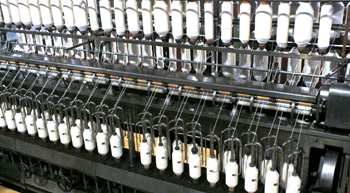
Spinning: A showcase of robust growth
Spinning has remained as an indispensable preliminary step to fabric formation in spite of many technological developments that provide the means to achieve direct conversion of fibres to fabrics. Ever since the spinning wheel was invented in India, first of the kinds of automation effort towards mechanisation
Spinning has remained as an indispensable preliminary step to fabric formation in spite of many technological developments that provide the means to achieve direct conversion of fibres to fabrics. Ever since the spinning wheel was invented in India, first of the kinds of automation effort towards mechanisation of the yarn production, the industry has grown from the status of an unorganised sector to multi-national corporates amidst uncertainties like global recession, raw material shortage, power demands and ever growing shortage of skilled manpower.
Invention of the Mule, which was the first machine that produced yarns, led to progressively increasing production by four to six fold. The introduction of water turbines for driving machines, led to mass production of yarns during the early period of 18th century, but these factories could only be established close to rivers and streams. The invention of the steam engine for driving machines allowed spinning industries to setup ´scale units everywhere, without any restrictions on location. After the advent of electricity and electric motors, spinning industries spread all over the world and are usually found in clusters in various countries. Technology improvements in materials, machinery and manufacturing processes have powered the spinning industry´s growth in terms of production, productivity and quality. Manchester was the leading producer of yarns and was considered the hub of the spinning industry until the World War I. Today, the industry has almost a dozen method of manufacturing yarn for various applications using different fibres. World cotton consumption has increased with two per cent average annual growth rate since 1940s. Today China, US and India are the largest producers of cotton yarns, and the 20th century also witnessed the invention of manmade fibres like viscose, polyester, etc., and provided additional raw material for the spinning industry. Manmade fibres along with natural fibres have taken spinning industry to its present glorious status.
After 1940, the advances in the spinning industry can be grouped into five key categories: viz, productivity, yarn quality, automation, development of testing equipment and newer methods to produce yarns.Advancement of spinning systems has passed through a long way from hand spinning, mule spinning, ring spinning, rotor spinning, friction spinning, airjet spinning, compact spinning and vortex spinning. Ring spinning, introduced in 1828 by an American named John Thorp, produce yarns of wide linear densities ranging from super fine to coarse yarns and, continues to rule the global yarn production even today.The original machine has undergone many structural changes to accommodate wide categories of fibres, short staple to long staple.Early research developments predominantly concentrated on raising production rates, but later looked to attain high quality yarns which became a prerequisite for producing fabrics on the looms that were becoming faster and better.Compact spinning, a variant of ring spinning technology, gives yarn of extremely good strength, evenness and smoothness due to minimised hairiness.
Next development of rotor spinning, which could be considered as a disruptive invention in yarn production, increased production rates by a factor of nearly ten and offered advantages like elimination of the need for a winding process which resulted in packages with less splices or knots.However, the limitation on the fineness of yarn that can be produced using this innovating method posed a serious restriction, though the yarns produced in rotor spinning system are more even with good abrasion resistance when compared with ring spun yarn.
In parallel with rotor spinning technology, friction spinning was also introduced; but was unable to capture attention of the market. Incapability to achieve required fibre orientation which in turn resulted in inferior yarn strength was the reason for its<



